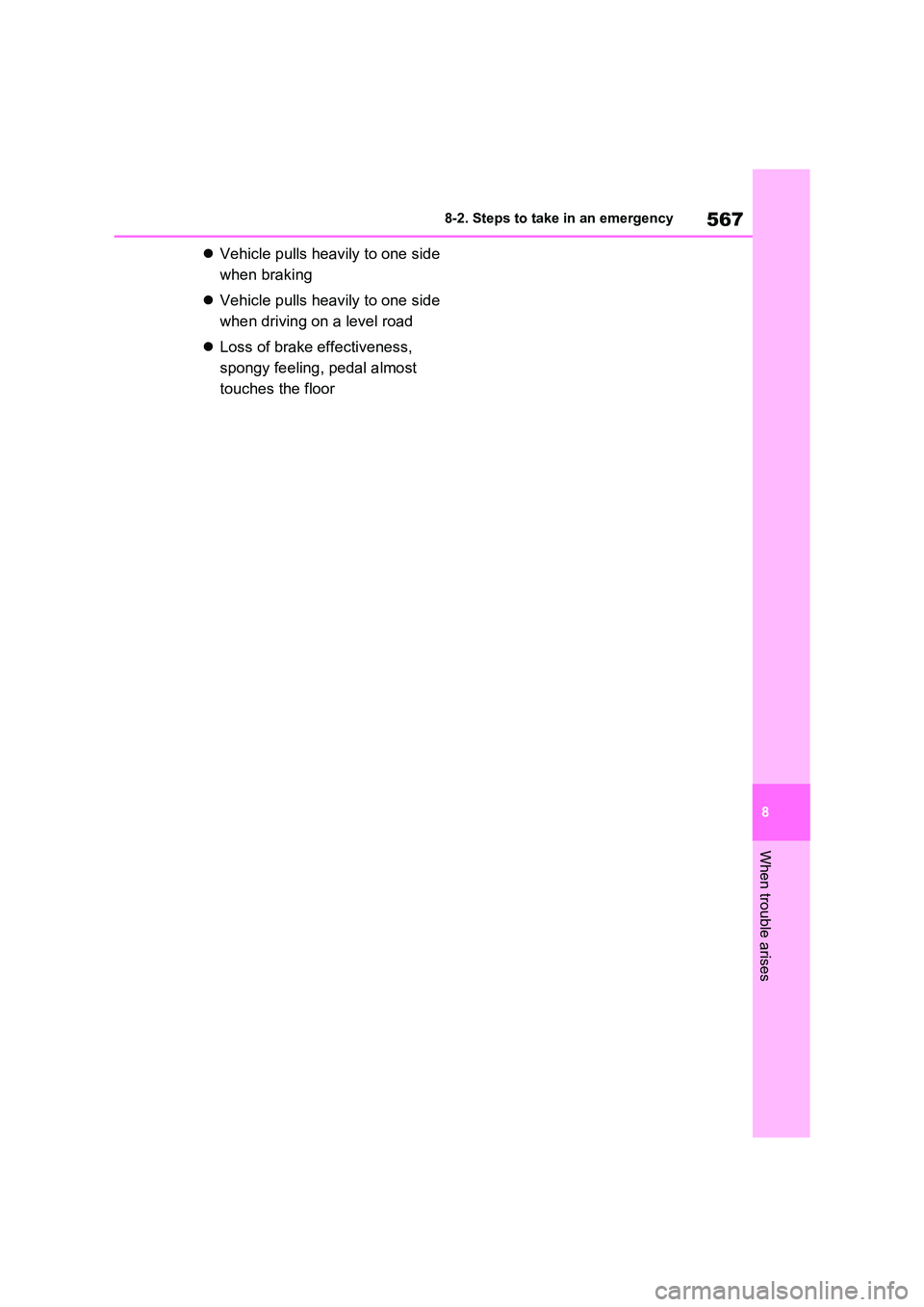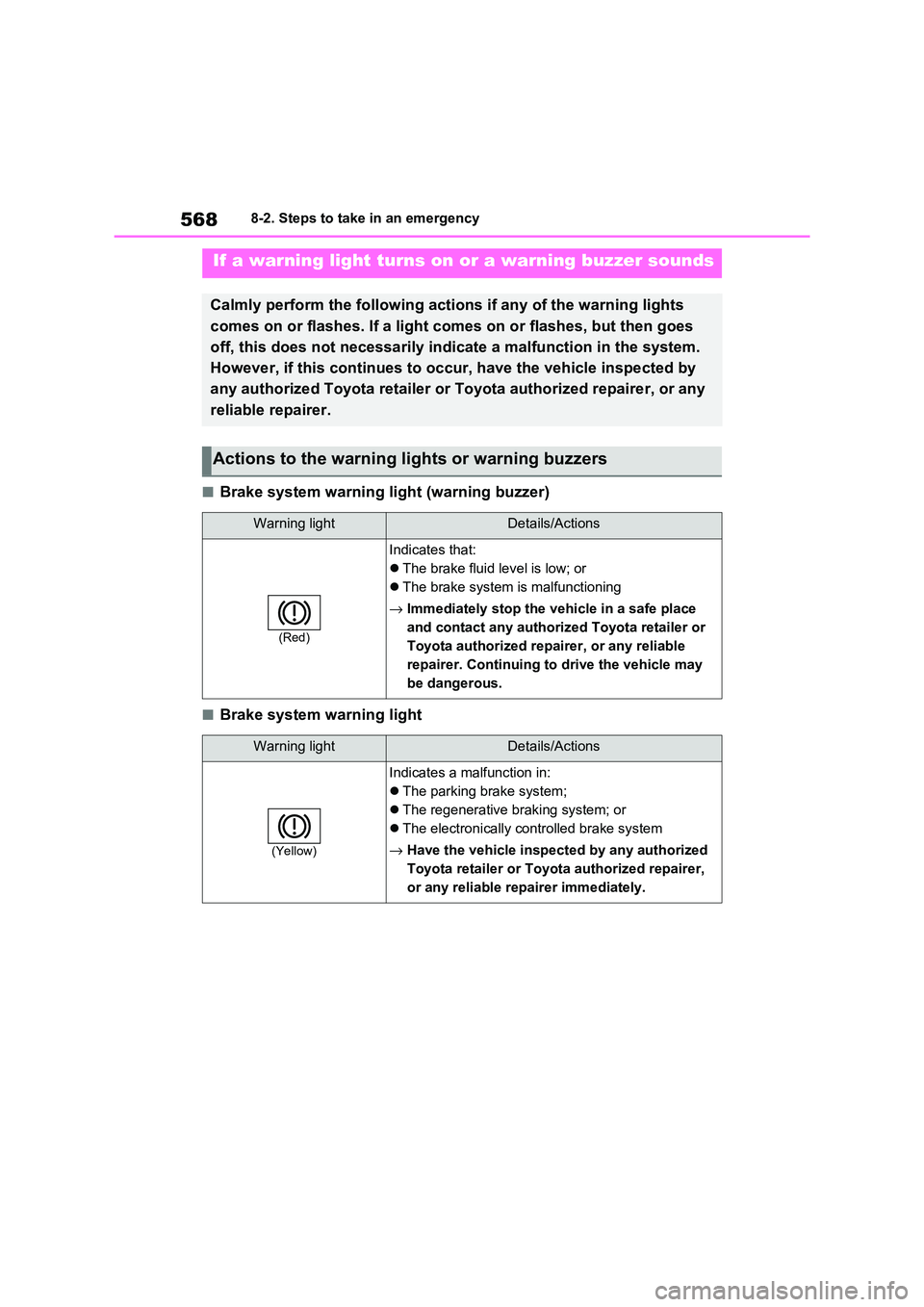2021 TOYOTA RAV4 PHEV brake
[x] Cancel search: brakePage 505 of 666

503
7
7-3. Do-it-yours elf maintenance
Maintenance and care
■Engine oil consumption
A certain amount o f engine oil will be
consumed while driving. In the following
situations, oil consumption may increase, and engine oil may need to be
refilled in between oil maintenance inter -
vals.
●When the engine is new, for example
directly after purchasing the vehicle or after replacing the engine
●If low quality oil or oil of an inappropri - ate viscosity is used
●When driving at high engine speeds or with a heavy load , when towing, or
when driving while accelerating or
decelerating frequently
●When leaving the engine idling for a
long time, or when driving frequently through heavy traffic
The coolant level is satisfactory if it
is between the “ FULL” and “LOW”
lines on the reservoir when the
hybrid system is cold.
■Engine coolant reservoir
Reservoir cap
“FULL” line
WARNING
■Used engine oil
●Used engine oil contains poten -
tially harmful contaminants which may cause skin di sorders such as
inflammation and skin cancer, so
care should be taken to avoid pro - longed and repeated contact. To
remove used engine oil from your
skin, wash thoroughly with soap and water.
●Dispose of used oi l and filters only in a safe and acceptable manner.
Do not dispose of used oil and fil -
ters in household trash, in sewers or onto the ground. Call any autho -
rized Toyota ret ailer or Toyota
authorized repairer, or any reliable repairer, service station or auto
parts store for in formation concern-
ing recycling or disposal.
●Do not leave used e ngine oil within
the reach of children.
NOTICE
■To prevent serious engine dam -
age
Check the oil level on a regular basis.
■When replacing the engine oil
●Be careful not to spill engine oil on the vehicle components.
●Avoid overfilling, or the engine
could be damaged.
●Check the oil leve l on the dipstick
every time you refill the vehicle.
●Be sure the engine oil filler cap is
properly tightened.
■If oil is spilled on the engine
cover
To prevent the engine cover from
being damaged, remove any engine
oil from the engine cover as soon as possible using a neutral detergent. Do
not use an organic solvent such as
brake cleaner.
Checking the coolant
A
B
Page 562 of 666

5608-1. Essential information
8-1.Essential information
Press the switch.
All the turn signal lights will flash.
To turn them off, press the switch once
again.
■Emergency flashers
●If the emergency flashers are used for a long time while the hybrid system is
not operating (while the “READY” indi -
cator is not illumi nated), the 12-volt battery may discharge.
●If any of the SRS airbags deploy (inflate) or in the event of a strong rear
impact, the emergency flashers will
turn on automatically.
The emergency flashers will turn off automatically after operating for
approximately 20 m inutes. To manu-
ally turn the emerg ency flashers off, press the switch twice. (The emer -
gency flashers may not turn on auto -
matically depending on the force of the impact and co nditions of the colli-
sion.)
1 Steadily step on the brake pedal
with both feet and firmly depress
it.
Do not pump the brake pedal repeat -
edly as this will in crease the effort required to slow the vehicle.
2 Shift the shift lever to N.
If the shift lever is shifted to N
3 After slowing down, stop the
vehicle in a saf e place by the
road.
4 Stop the hybrid system.
If th e s hif t le ver ca nn o t b e s hif te d
to N
3 Keep depressing the brake
pedal with both feet to reduce
vehicle speed as much as possi -
ble.
Press and hold the power switch for 2
consecutive seconds or more, or press
Emergency flashers
The emergency flashers are
used to warn other drivers
when the vehicle has to be
stopped in the road due to a
breakdown, etc.
Operating instructions
If your vehicle has to be
stopped in an emer-
gency
Only in an emergency, such as
if it becomes impossible to
stop the vehicle in the normal
way, stop the vehicle using the
following procedure:
Stopping the vehicle
Page 567 of 666

565
8
8-2. Steps to take in an emergency
When trouble arises
When using a flat-bed truck to
transport the vehicle, use tire strap -
ping belts. Refer to the owner’s
manual of the flat-bed truck for the
tire strapping method.
In order to supp ress vehicle move-
ment during transportation, set the
parking brake and turn the power
switch off.
If a tow truck is not available in an
emergency, your vehicle may be
temporarily towed using cables or
chains secured to the emergency
towing eyelets. This should only be
attempted on hard surfaced roads
for short distances at under 30
km/h (18 mph).
A driver must be i n the vehicle to
steer and operate the brakes. The
vehicle’s wheels, drive train, axles,
steering and brakes must be in
good condition.
To have your vehicle towed by
another vehicle, the towing eyelet
must be installed to your vehicle.
Install the towing eyelet using the
following procedure.
1 Take out the wheel nut wrench
and towing eyelet. ( →P.583,
594)
2 Using a flathead screwdriver,
remove eyelet cover ( ), and
then remove eyelet cover ( ).
To protect the bodywork, place a rag
between the screwdriver and the vehi - cle body as shown in the illustration.
3 Insert the towing eyelet into the
hole and tighten partially by
hand.
4 Tighten down the towing eyelet
securely using a wheel nut
wrench (if equipped) or hard
metal bar.
Using a flatbed truck
Emergency towing
Emergency towing proce -
dure
A
B
Page 568 of 666

5668-2. Steps to take in an emergency
5Securely attach cables or chains
to the towing eyelet.
Take care not to damage the vehicle
body.
6 Enter the vehicle being towed
and start the hybrid system.
Turn off the Parking Support Brake
function. (if equipped): →P.420
If the hybrid system d oes not start, turn
the power switch to ON.
7 Shift the shift lever to N and
release the parking brake.
Turn automatic mode off. ( →P.327)
When the shift lever cannot be shifted:
→ P.323
■While towing
If the hybrid system is not running, the
power assist for the brakes and steering will not function, making steering and
braking more difficult.
■Wheel nut wrench (if equipped)
Wheel nut wrench is installed in the deck under tray. ( →P.583, 594)
Fluid leaks under the vehicle
(Water dripping from the air con -
ditioning after use is normal.)
Flat-looking tires or uneven tire
wear
High coolant temperature warn-
ing light flashes or come on
Changes in exhaust sound
Excessive tire squeal when cor-
nering
Strange noises related to the
suspension system
Pinging or other noises related to
the hybrid system
Engine missing, stumbling or
running roughly
Appreciable loss of power
If you think something is
wrong
If you notice any of the follow -
ing symptoms, your vehicle
probably needs adjustment or
repair. Contact any authorized
Toyota retailer or Toyota
authorized repairer, or any reli -
able repairer as soon as possi -
ble.
Visible symptoms
Audible symptoms
Operational symptoms
Page 569 of 666

567
8
8-2. Steps to take in an emergency
When trouble arises
Vehicle pulls heavily to one side
when braking
Vehicle pulls heavily to one side
when driving on a level road
Loss of brake effectiveness,
spongy feeling, pedal almost
touches the floor
Page 570 of 666

5688-2. Steps to take in an emergency
■Brake system warning light (warning buzzer)
■Brake system warning light
If a warning light turns on or a warning buzzer sounds
Calmly perform the following actions if any of the warning lights
comes on or flashes. If a light c omes on or flashes, but then goes
off, this does not necessarily i ndicate a malfunction in the system.
However, if this continues to occur, have the vehicle inspected by
any authorized Toyota retailer or Toyota authorized repairer, o r any
reliable repairer.
Actions to the warning lights or warning buzzers
Warning lightDetails/Actions
(Red)
Indicates that:
The brake fluid level is low; or
The brake system is malfunctioning
→ Immediately stop the vehicle in a safe place
and contact any authorized Toyota retailer or
Toyota authorized repairer, or any reliable
repairer. Continuing to drive the vehicle may
be dangerous.
Warning lightDetails/Actions
(Yellow)
Indicates a ma lfunction in:
The parking brake system;
The regenerative braking system; or
The electronically controlled brake system
→ Have the vehicle inspected by any authorized
Toyota retailer or Toyota authorized repairer,
or any reliable re pairer immediately.
Page 572 of 666

5708-2. Steps to take in an emergency
■Malfunction indicator lamp*
*: This light illuminates on the multi-information display.
■SRS warning light
■ABS warning light
■Electric power steering system warning light* (warning buzzer)
*: This light illuminates on the multi-information display.
Warning lightDetails/Actions
Indicates a malfunction in:
The hybrid system;
The electronic engine control system;
The electronic throttle control system; or
The emission control system (if equipped)
→ Have the vehicle inspected by any authorized
Toyota retailer or Toyota authorized repairer,
or any reliable re pairer immediately.
Warning lightDetails/Actions
Indicates a malfunction in:
The SRS airbag system; or
The seat belt pretensioner system
→ Have the vehicle inspected by any authorized
Toyota retailer or Toyota authorized repairer,
or any reliable re pairer immediately.
Warning lightDetails/Actions
Indicates a malfunction in:
The ABS; or
The brake assist system
→ Have the vehicle inspected by any authorized
Toyota retailer or Toyota authorized repairer,
or any reliable re pairer immediately.
Warning lightDetails/Actions
(Red/yellow)
Indicates a malfunction in the EPS (Electric Power
Steering) system
→ Have the vehicle inspected by any authorized
Toyota retailer or Toyota authorized repairer,
or any reliable re pairer immediately.
Page 574 of 666

5728-2. Steps to take in an emergency
■Toyota parking assist-sensor OFF indicator* (warning buzzer)
*: This light illuminates on the multi-information display.
■PKSB OFF indicator*
*: This light illuminates on the multi-information display.
Warning lightDetails/Actions
(If equipped)
When a buzzer sounds:
Indicates a ma lfunction in the Toyota parking assist-
sensor function
→ Have the vehicle inspected by any authorized
Toyota retailer or Toyota authorized repairer,
or any reliable re pairer immediately.
When a buzzer does not sound:
Indicates that the system is temporarily unavailable,
possibly due to a sensor being dirty or covered with
ice, etc.
→ Follow the instructions displayed on the multi-
information display. ( →P.416, 578)
Warning lightDetails/Actions
(If equipped)
If “Parking Support Brake Malfunction Visit Your
Dealer” is displayed on the multi-information display:
Indicates a malfun ction in the PKSB (Parking Support
Brake) system
→ Have the vehicle inspected by any authorized
Toyota retailer or Toyota authorized repairer,
or any reliable re pairer immediately.
If “Parking Assist Unavaila ble” is displayed on the
multi-information display:
Indicates that the system is temporarily unavailable,
possibly due to a sensor being dirty or covered with
ice, etc.
→ Follow the instructions displayed on the multi-
information display. ( →P.424, 578)